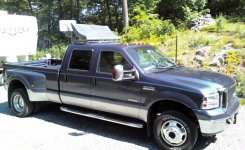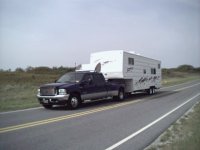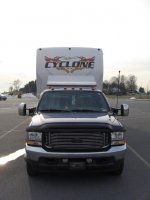You are using an out of date browser. It may not display this or other websites correctly.
You should upgrade or use an alternative browser.
You should upgrade or use an alternative browser.
Any experience with wind deflectors?
- Thread starter Bksvo
- Start date
Ray LeTourneau
Senior Member - Past Moderator
Bksvo, With the front cap design of the Cyclone, I can't imagine and advantage to adding a deflector. Our previous 5th wheel was lighter and smaller and had a flat front with a slight angle to the rear. Our much heavier Bighorn seemed much easier to pull even in a headwind. My opinion, save your money.
Probably good advice. You've seen many a pickup with a net instead of a tailgate. It was supposed to improve gas mileage and it is also COOL. It's been proven that they don't save fuel but I suppose they are still COOL. Save you're $$$. Now if you were to add all the small improvements to aerodynamics that have been incorporated into today's vehicles it probably does add up to significant fuel savings. I always told my students that if it really did improve fuel mileage then Detroit would have incorporated it into their vehicles. Several years ago our esteemed school district, at the advice of a new assistant superintendent installed magnets around the fuel lines on 70 of our school buses. They were installed on the bus that I drove. It cost them $14,000 ($200 for each bus). Had they bothered to call me for some advice I could have told them to save their $$$$. But they know all the answers. That old wives tale has been around for years and there is not a shred of truth to it. If there were there is a magnetic field inside of your alternator and Detroit could run your fuel line through or around your alternator and improve your fuel mileage. But they don't because it won't work.
TeJay
TeJay
fjspinelli
Common Sense Jake
 I run with a deflector on the roof of my truck. The advantage has been a 1, and sometimes 2 MPG, advantage over going without. However I find the that the most important advantage has been that the truck and trailer "track" through the wind and are more stable while driving. The deflector takes out some of the vibration of the wind hitting the front of the trailer as well. I purchased the unit I use now used, but would love to purchase a new stainless steel one, with an extension that gets the last 12 to 18 inches of air up and over the trailer.
I run with a deflector on the roof of my truck. The advantage has been a 1, and sometimes 2 MPG, advantage over going without. However I find the that the most important advantage has been that the truck and trailer "track" through the wind and are more stable while driving. The deflector takes out some of the vibration of the wind hitting the front of the trailer as well. I purchased the unit I use now used, but would love to purchase a new stainless steel one, with an extension that gets the last 12 to 18 inches of air up and over the trailer.Before purchasing a unit I borrowed a deflector for a run we did to Myrtle Beach. I started without it. Got fuel in lower PA and put the flap up. Next fueling in VA I put it down.....I made it about 15 minutes before I stopped and put it back up.
My 2 cents delivered.
FJ
Last edited:
Whether they work depends pretty much on the shape of the front of your trailer. The blunter it is, the more the deflector will work. One problem with the manufactured deflectors is they are too narrow. Wind needs to be deflected to the side as well as up. A South Australia Caravan Club member did a lot of research on them and came up with this: the deflector should cover about 70% of the area above the TV both vertically and to the side. The magic number is 45°-the angle back and to the side. I followed their directions and build one that I used for my last two trailers-not Heartlands. My 21FBS is aerodynamic enough without. I tested it several times on trips to the Oregon coast, going the same way each time. I saved between 12% and 17% in gas usage. When I bought my last non Heartland trailer I modified it a bit-different profile-and came up with the same figures.
Bksvo
Well-known member
The advantage has been a 1, and sometimes 2 MPG, advantage over going without.
I am a bang for the buck guy, so 1-2mpg for me would be a 12-25% increase in fuel economy, which would pay for itself rather quickly. Keeping the bugs off would be icing on the cake.
I asked a guy that had one on his truck and he claimed that he gained about 50 miles per tank with his previous 5th wheel, but not as much with his present travel trailer as the distance between deflector and trailer is too great to be effective. He had his mounted on a bracket right behind the cab.
Shortly after seeing that deflector we took a trip and I paid attention to how many semis have deflectors, and I'd guess about 90% or better have them, usually integrated with the cab. Now obviously there is something to be gained with those kind of numbers with that widespread usage, and I found a test report online that came up with about 15% savings with a complete aero kit on a semi (both cab and trailer). Now keep in mind that a 5th wheel is more aerodynamic than a trailer to begin with, a deflector for our trucks will not match the efficiency of those semis' integrated designs, that the savings only occur when you tow, and your mileage may actually go down with a deflector when not towing (even with one that can be lowered, due to the increased weight).
With that said, they look cool, may help with the bugs and stability especially if you don't have a dually, and may even save money if you primarily tow with your truck and put on a decent number of miles. For example, 50,000 miles at 12mpg and diesel for $3.50 is about $14,600, so saving about 10% or $1,460 would probably pay for the deflector.
Shortly after seeing that deflector we took a trip and I paid attention to how many semis have deflectors, and I'd guess about 90% or better have them, usually integrated with the cab. Now obviously there is something to be gained with those kind of numbers with that widespread usage, and I found a test report online that came up with about 15% savings with a complete aero kit on a semi (both cab and trailer). Now keep in mind that a 5th wheel is more aerodynamic than a trailer to begin with, a deflector for our trucks will not match the efficiency of those semis' integrated designs, that the savings only occur when you tow, and your mileage may actually go down with a deflector when not towing (even with one that can be lowered, due to the increased weight).
With that said, they look cool, may help with the bugs and stability especially if you don't have a dually, and may even save money if you primarily tow with your truck and put on a decent number of miles. For example, 50,000 miles at 12mpg and diesel for $3.50 is about $14,600, so saving about 10% or $1,460 would probably pay for the deflector.
dewwood
Well-known member
I don't have one but have considered it because as was noted above most semi's have some kind of aero package. One other benefit would be it would greatly reduce the amount of air flowing under the nose of the trailer which creates a huge whirlwind effect in the bed of your truck. How many of us have lost something out of the bed because it got sucked out? I know I am very careful what I put in the bed of the truck.
rick_debbie_gallant
Well-known member
Those big semi's also have the ground draft side boards under the trailer. I wonder how that would help.
Bob Vaughn
Well-known member
I forgot mine this trip and I almost ran out of gas getting to the first fuel stop that I always fuel up at. On my 3000 mile trip i was down 2 MPG. I will not forget again!!!!!
truknutt
Committed Member
As Porthole stated I run two styles of deflector; I have the stainless w/extension for the 350 and the Ultra-Fab Trail-Eze II for the 450. My original 5th wheel was a National RV Rage'N toyhauler..front nose was nearly vertical & box-like. It acted as a parachute going down the road. I started with just the stainless wing but couldn't get the bugline up and over the leading edge. I added the extension (for use with 11 footers and taller) and we did really well. I have removed the extension and use just the wing when hauling my open car trailer. Disadvantage - - won't fit in the garage!
I added the Trail-Eze to the 450 simply to keep the bugs off the front of the Cyclone. The unit is not angled enough side-to-side nor wide enough to keep the entire front end clean. The other advantage is that I can lay the deflector down and provide shade for the back seat passengers..and she fits in the garage!!
The deflector has to be as close to the trailer as possible; both deflector manufacturers stated so in their install instructions. A short box truck would have the advantage here. In my opinion, the Heartland nose cone reaps no aero advantage from a deflector.
Here are some pics of my old trailer:
I added the Trail-Eze to the 450 simply to keep the bugs off the front of the Cyclone. The unit is not angled enough side-to-side nor wide enough to keep the entire front end clean. The other advantage is that I can lay the deflector down and provide shade for the back seat passengers..and she fits in the garage!!
The deflector has to be as close to the trailer as possible; both deflector manufacturers stated so in their install instructions. A short box truck would have the advantage here. In my opinion, the Heartland nose cone reaps no aero advantage from a deflector.
Here are some pics of my old trailer:
Attachments
truknutt
Committed Member
And when Dave is done towing his trailer he hits the outlaw tracks
iPhone using Tapatalk
Took me a while on that one....Outlaw to me refers to Nona's family so....
trvlrerik
Well-known member
I don't know if the height of the rig makes any difference, I do know that if I have 3 kayaks on the roof of my truck in front of the Cyclone the nose stays pretty clean, with an aluminum wing there is no measurable difference in my mileage however.
On my work trailers (featherlights) I put an aluminum wing the same width as the truck and nearly the same height as the trailer and it does help milage a little, the main thing it helps is keeping the light stuff in the back of the truck from being blown around (or out of) the bed of the truck, and keeping the trailer nose spotless and chip free. The aluminum is easily washed and re-polished.
On my work trailers (featherlights) I put an aluminum wing the same width as the truck and nearly the same height as the trailer and it does help milage a little, the main thing it helps is keeping the light stuff in the back of the truck from being blown around (or out of) the bed of the truck, and keeping the trailer nose spotless and chip free. The aluminum is easily washed and re-polished.
jimtoo
Moderator
Does a woman run faster than a man? Wid deflectors are absolute hype!
Well,,, most women have great wind deflectors, so it should really help them run faster,,,, BUT,,they usually have their mouth open, talking.... that really messes up the air flow...makes the air go the wrong... aww.. never mind...
BOY,,, am I in trouble now.. but just couldn't resist..
Anominous
caissiel
Senior Member
I towed an SOB with angled flat front and there was lots wind pressure on the front and even cracked it. The Heartland 5th wheels do have a very aero front so much that the Fuel mileage on my truck is 20% better then the previous SOB.
I read somewhere and Cummings covers it on their truck fuel economy site, that the installation is very important for proper performance, and it has to be equal frontal area and as close to the trailer front as possible.
I find that it makes my truck look weak having a deflector, and its a fuel killer when not towing. every inch over the cab adds enormous drag. I just returned from a 100 mile trip with a load of lumber in the truck box and the fuel mileage was the best I have ever done with this truck, due to the smooth flow with a full box without a large vaccuum created behind the cab. The weight of the load had no effect on mileage.
There is a study somewhere that indicates that a rear deflector on the rear is the best fuel saver, and no one is using it. Like the deflectors in the rear of the Station Wagons in the 50-70's. A vaccum creates more drag than deflected air, so every setup has to eliminate any chance of creating such a vaccum between cab and trailer. So rear deflectors cleans this big vacuum at the rear of the trailer. Just follow behind a semi and feel the pull created by the flat square trailer rear form. Also Cummings information states that at 55mph wind drag is negligible and very important at higher speed and the drag increase exponentially to the point of needing proper wind deflection setup on semis.
I read somewhere and Cummings covers it on their truck fuel economy site, that the installation is very important for proper performance, and it has to be equal frontal area and as close to the trailer front as possible.
I find that it makes my truck look weak having a deflector, and its a fuel killer when not towing. every inch over the cab adds enormous drag. I just returned from a 100 mile trip with a load of lumber in the truck box and the fuel mileage was the best I have ever done with this truck, due to the smooth flow with a full box without a large vaccuum created behind the cab. The weight of the load had no effect on mileage.
There is a study somewhere that indicates that a rear deflector on the rear is the best fuel saver, and no one is using it. Like the deflectors in the rear of the Station Wagons in the 50-70's. A vaccum creates more drag than deflected air, so every setup has to eliminate any chance of creating such a vaccum between cab and trailer. So rear deflectors cleans this big vacuum at the rear of the trailer. Just follow behind a semi and feel the pull created by the flat square trailer rear form. Also Cummings information states that at 55mph wind drag is negligible and very important at higher speed and the drag increase exponentially to the point of needing proper wind deflection setup on semis.
Similar threads
- Replies
- 1
- Views
- 763
- Replies
- 7
- Views
- 2K





